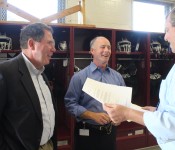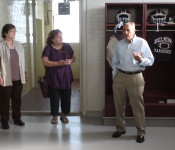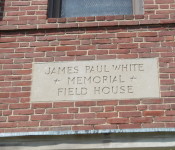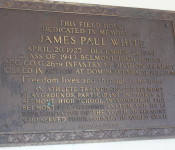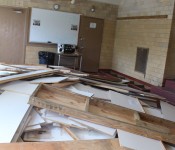For generations of Belmont High School athletes, the White Field House was known for being a dank and dingy building where the lockers were old and narrow and the interior dark and smelly.
What a difference a summer of hard work – and approximately $100,000 in contributions and in-kind contributions – can do.
Through the efforts of parents of current athletes and past players, craftsmen and contractors, the interior of the nearly 83-year-old brick building on Concord Avenue has been transformed into a welcoming place for student athletes when school and town officials toured the Belmont School District-owned site on Monday, Aug. 25.
“Before you might have walked in and said ‘When are we going to tear this place down?’,” said Frederick Jones, who led the effort in renovating the site.
“The hope is that this will be an inspiration. Let’s make this the beginning of a commitment,” he said.
The walls in nearly every room in the two-story building are now lined with newly-installed lockers, the entire interior was thoroughly scrubbed and cleaned (for the first time in years), layers of paint stripped and replaced with a white coat, light fixtures replaced and modernized as floors were repaired and refurbished. Soon there will be an internet connection at the field house to allow the teams to review game film.
And the bronze memorial for James Paul White, a 19-year-old Belmont resident who died in the Battle of the Bulge in 1944, was cleaned and polished, sparkling was it did in 1948 when the building was named in his honor.
“The good story is that at the beginning of the season, the town has a renovated White Field House and Harris Field, which are both town assets,” said David Kale, Belmont’s Town Administrator.
Led by Woodfall Road’s Jones, a small committee made up of Larry Christofori, and Bob Delhome and Eric Aulenback –both former Marauder football players and Belmont High graduates – spearheaded the work with both cash contributions and using their contacts to solicit both volunteers and contributions to the cause.
“There was a lot of sweat equity by the members of this group,” said Jones. Christofori said the monetary and the in-kind contributions – which totaled $100,000 – worked hand-in-hand in bringing the project to completion.
“There is leverage when you come up with $50,000 in cash contributions. People see that we had the wherewithal, and it attracts a whole lot more people. They see it being successful, and they want to be part of it,” said Christofori.
He pointed out a few individuals who took on the challenge: Bob Aiello of JDC Demolition took care of all demolition, absorbing that cost; Gene Vetrano, owner of EJ Vetrano Painting and Wallpapering, put in more than 400 hours of labor into the project with top-of-the-line material at substantially below his actual cost; and John Rumley, owner of Rumley Electric, took care of all electrical work, new lighting and safety lighting at substantially below cost.
In addition, Dennis Rocha of D.Rocha Construction, Tom Ferraro of Northeast Industrial Tech and Jon Baldi provided “jack-of-all trade” services on small, but challenging job when needed.
The group also took a look at the renovated Harris Field and Track, the main playing surface for multiple teams in Belmont. The project, financed by the continuation of a bond approved by a special Town Meeting in 2013, cost about $850,000, approximately $100,000 less than originally estimated, said Peter Castanino, director of the Department of Public Works. Besides a state-of-the-art padded artificial Turf field, the field has a new track surface, fencing and padding. New drain covers will be coming soon.
And it will be the athletes who will benefit from the improvements.
“Coming off the back of a difficult season last year, we’re very blessed to have these two new spaces and very grateful to all the people who did this out of the goodness of their hearts,” said Belmont Head Football Coach Yann Kumin.
